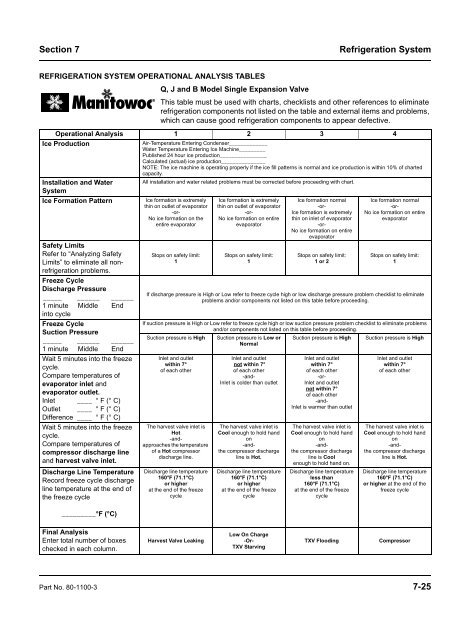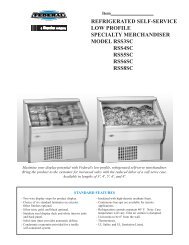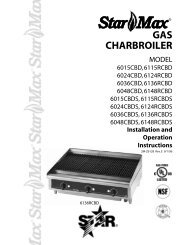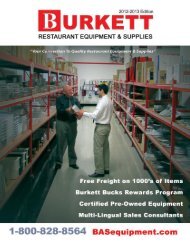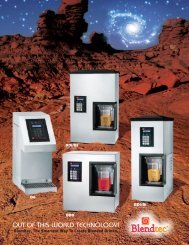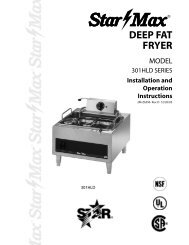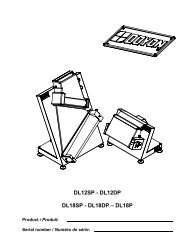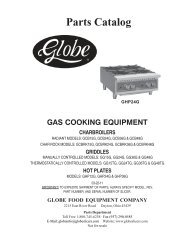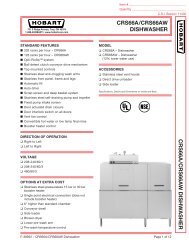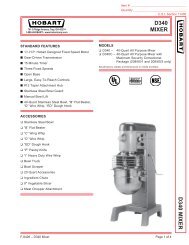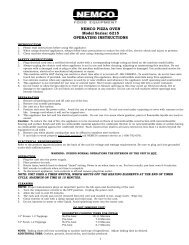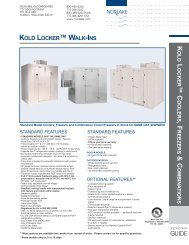ICE MACHINES Q-Model Service Manual
ICE MACHINES Q-Model Service Manual
ICE MACHINES Q-Model Service Manual
- No tags were found...
You also want an ePaper? Increase the reach of your titles
YUMPU automatically turns print PDFs into web optimized ePapers that Google loves.
Section 7Refrigeration SystemREFRIGERATION SYSTEM OPERATIONAL ANALYSIS TABLESQ, J and B <strong>Model</strong> Single Expansion ValveThis table must be used with charts, checklists and other references to eliminaterefrigeration components not listed on the table and external items and problems,which can cause good refrigeration components to appear defective.Operational Analysis 1 2 3 4Ice ProductionInstallation and WaterSystemIce Formation PatternSafety LimitsRefer to “Analyzing SafetyLimits” to eliminate all nonrefrigerationproblems.Freeze CycleDischarge Pressure_____ ______ ______1 minute Middle Endinto cycleFreeze CycleSuction Pressure_____ ______ ______1 minute Middle EndWait 5 minutes into the freezecycle.Compare temperatures ofevaporator inlet andevaporator outlet.Inlet ____ ° F (° C)Outlet ____ ° F (° C)Difference ____ ° F (° C)Wait 5 minutes into the freezecycle.Compare temperatures ofcompressor discharge lineand harvest valve inlet.Discharge Line TemperatureRecord freeze cycle dischargeline temperature at the end ofthe freeze cycle_________°F (°C)Air-Temperature Entering Condenser_____________Water Temperature Entering Ice Machine_________Published 24 hour ice production________________Calculated (actual) ice production_______________NOTE: The ice machine is operating properly if the ice fill patterns is normal and ice production is within 10% of chartedcapacity.All installation and water related problems must be corrected before proceeding with chart.Ice formation is extremelythin on outlet of evaporator-or-No ice formation on theentire evaporatorStops on safety limit:1Ice formation is extremelythin on outlet of evaporator-or-No ice formation on entireevaporatorStops on safety limit:1Ice formation normal-or-Ice formation is extremelythin on inlet of evaporator-or-No ice formation on entireevaporatorStops on safety limit:1 or 2Ice formation normal-or-No ice formation on entireevaporatorStops on safety limit:1If discharge pressure is High or Low refer to freeze cycle high or low discharge pressure problem checklist to eliminateproblems and/or components not listed on this table before proceeding.If suction pressure is High or Low refer to freeze cycle high or low suction pressure problem checklist to eliminate problemsand/or components not listed on this table before proceeding.Suction pressure is HighInlet and outletwithin 7°of each otherThe harvest valve inlet isHot-andapproachesthe temperatureof a Hot compressordischarge line.Discharge line temperature160°F (71.1°C)or higherat the end of the freezecycleSuction pressure is Low orNormalInlet and outletnot within 7°of each other-and-Inlet is colder than outletThe harvest valve inlet isCool enough to hold handon-andthecompressor dischargeline is Hot.Discharge line temperature160°F (71.1°C)or higherat the end of the freezecycleSuction pressure is HighInlet and outletwithin 7°of each other-or-Inlet and outletnot within 7°of each other-and-Inlet is warmer than outletThe harvest valve inlet isCool enough to hold handon-andthecompressor dischargeline is Coolenough to hold hand on.Discharge line temperatureless than160°F (71.1°C)at the end of the freezecycleSuction pressure is HighInlet and outletwithin 7°of each otherThe harvest valve inlet isCool enough to hold handon-andthecompressor dischargeline is Hot.Discharge line temperature160°F (71.1°C)or higher at the end of thefreeze cycleFinal AnalysisEnter total number of boxeschecked in each column.Harvest Valve LeakingLow On Charge-Or-TXV StarvingTXV FloodingCompressorPart No. 80-1100-3 7-25


